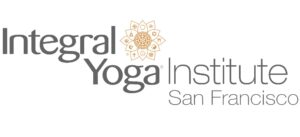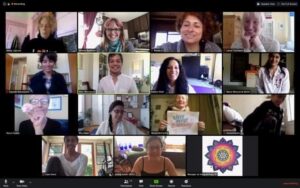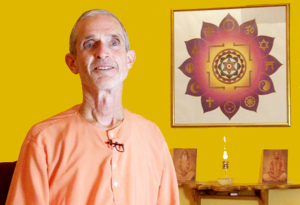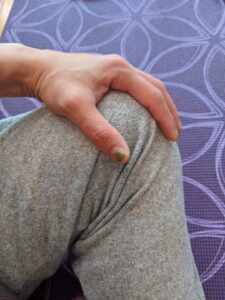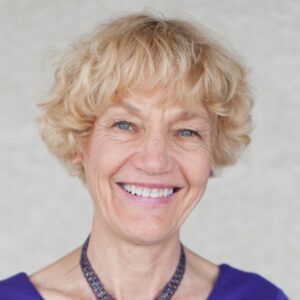Passing the Yoga Teacher Training Through Zoom by Mia Velez
Enrolling in a Yoga teacher training is a very personal decision. Whether motivated by a potential career change, or to enhance one’s understanding of Yoga, one would have to arrange one’s life to commit to 200 hours of training. At Integral Yoga Institute, students get an in-depth experience of Yoga. For each asana, they learn safety precautions, modifications, duration, and how to teach the posture. They are taught how to practice and how to teach pranayama and meditation while incorporating these disciplines (asana, pranayama and meditation) into a daily sadhana practice. There are human anatomy classes, scripture study, and they are asked to abstain from chemicals that alter the mental state, such as recreational drugs, alcohol, and even caffeine.
Going through the Integral Yoga Basic Hatha Teacher Training is a rigorous endeavour designed for a transformational experience. On May 19, 2020 twelve such individuals met the milestone that marked their persistence through the training. Dressed in white clothes to identify themselves as teachers (and no longer trainees), they logged on to their devices and made their mark in IYI’s history as the first class to ever graduate on a virtual platform. Their families from different parts of the world witnessed the graduation and learned a bit more of their new found discipline thanks to the unique circumstance of having to Shelter-In-Place (SIP).
The spring teacher training (TT) began late February 2020. The attendees shared their eagerness to begin their training: some waited for the right time, financial opportunity, or the right place that resonated with them. The overall goal was to deepen their knowledge of Yoga. Compared to a typical Yoga class that lasts 60-90min, a trainee is obligated to take one of these classes once a week, attend 15 hours a week of instruction, and incorporate a daily personal practice. These requirements have been relatively the same for the past forty years. For this group however, more was to be expected from them as the course transitioned from an in-person model to a virtual platform. Three weeks into the training, the Coronavirus pandemic landed on San Francisco soil. At first, only some students who were at a higher risk for severe illness attended the class from their home through Zoom, while the rest continued to come to the ashram. When the city mandated everyone to SIP however, it relegated the teacher training to being completely online.
The transition to a virtual setting appeared to be seamless. Everyone adjusted quickly and kept a positive attitude hoping that the mandate would soon be lifted. However, as the COVID-19 death toll increased, the mandate did not seem to end in time for graduation. The jarring new reality and uncertainty plagued everyone in different ways. The teachers had to adjust the schedule to meet the TT standard: training days were added on scheduled days off to make up for the canceled three day retreat, the Anatomy course had to be rearranged because one of the teachers had to attend to COVID-19 measures at her job, certain workshops, like the Hands On Adjustment, could not be taught online and technological glitches interfered with the day’s agenda. The students graciously adjusted to the many revisions despite their own personal challenges: some lost their income as the quarantine orders forced many businesses to close, those who lived alone felt the loneliness of isolation, and daily bouts of anxiety for some made daily tasks a difficult endeavour.
Yet, every Tuesday and Thursday evening, and for nine hours on Sunday they all logged in for class. The Zoom gathering became a place of solace. Discussing the Yoga Sutras, practicing pranayama, dissecting the asanas and of course checking in with each other put life’s challenges into perspective. Over the course of three months, the students and teachers held each other in community. They celebrated a birthday, cheered for each other’s achievements like going into a shoulder stand for the first time or nailing the Hari Om chant. They held each other accountable by meeting online between classes to practice. If anyone fell into despair, the collective encouraged, supported, and reached out to pull that person out of the darkness and back into the Light. Despite the difficulties that emerged from the pandemic, it was still possible to cultivate peace, and the group thrived with the Yogic tools they were learning.
Training during the pandemic offered a unique opportunity. Leaving the house for the ashram creates a buffer between your personal life and Yoga. To some extent, you control your narrative by choosing what in your life you want to reveal. The SIP however, exposed more than intended. Students and teachers alike were now opening their personal space: their living rooms, kitchens, and bedrooms to each other; and partners, roommates, children and pets made appearances during class. While the physical distance was felt, the online interface created an intimate look into each other’s lives. Yoga integrated further into their personal space with an assignment to create a dedicated area to usher in the essence of Yoga during class. More importantly, the lockdown touched on the basic principle of Yoga – which is stillness. Social distancing, self-isolation, limited travel and the silence that often resulted from the inactivity offered a unique environment for students to tap deeper into that stillness. While old wounds may have bubbled up as a result of the inactivity, Yoga training helped to courageously face and overcome the hardships.
Completing the teacher training requires commitment, perseverance and best of all, community. Weathering the storm of fear and uncertainty using the science of Yoga, the graduates earned their place in the graduation. The evening was bittersweet as we celebrated the graduates while acknowledging the end of our regular meeting. The evening ended with music and dancing as we rejoiced in their accomplishment as the new torchbearers, bringing the Light of Yoga into the world.
On behalf of IYI San Francisco, the yoga teachers and mentors: Swami Ramananda, Swami Divyananda, Marc Mukunda Morozumi, Mia Velez, Sivadas, Angie, Eric Gustafson, Marie Prashanti Goodell, Sarah Asha Weidman, Pranava, Lucy Young, Kayko Watanabi, we wish the newest graduates the greatest success in their lives. A BIG Congratulations to:
Annie Karuna Linton
Fakhra Shah
Gaia Davis
Hannah Rosenstein
Laura Lalita Travisano
Louise Chiodo
Maria Madhavi Becht
Nicola Nandini McCarthy
Raisa Punkki
Renda Dabit
Soizig Le Boulch
Verena Rueckert

